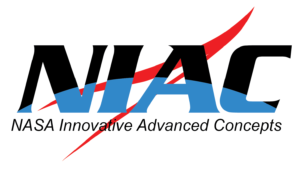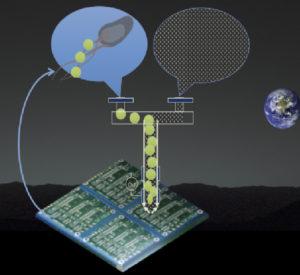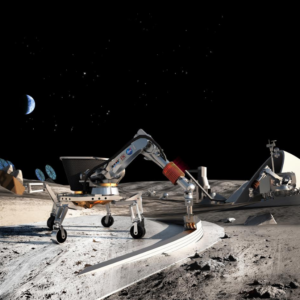 On Sunday, I attended Star Trek: Mission New York at the Jacob Javits Convention Center. One of the many celebratory events commemorating the 50th anniversary of the seminal science fiction television series, the convention featured talks with the casts of the original show and spinoffs, photos and autograph signings with the actors, and plenty of Star Trek merchandise on hand for eager Trekkies (or Trekkers) to purchase. Of course, I had to sit in the captain’s chair on a replica of the original Enterprise bridge. And getting commemorative Star Trek US postal stamps before they were released to the general public, and inked with special cancellation stamps only available at the show, was pretty cool. But what I didn’t expect to see, and was by far the coolest thing at the convention, was the large NASA section representing some of the national space agency’s many different programs. One booth that especially caught my interest was that of the NASA Innovative Advanced Concepts program.
On Sunday, I attended Star Trek: Mission New York at the Jacob Javits Convention Center. One of the many celebratory events commemorating the 50th anniversary of the seminal science fiction television series, the convention featured talks with the casts of the original show and spinoffs, photos and autograph signings with the actors, and plenty of Star Trek merchandise on hand for eager Trekkies (or Trekkers) to purchase. Of course, I had to sit in the captain’s chair on a replica of the original Enterprise bridge. And getting commemorative Star Trek US postal stamps before they were released to the general public, and inked with special cancellation stamps only available at the show, was pretty cool. But what I didn’t expect to see, and was by far the coolest thing at the convention, was the large NASA section representing some of the national space agency’s many different programs. One booth that especially caught my interest was that of the NASA Innovative Advanced Concepts program.
The NASA Innovative Advanced Concepts (NIAC) program focuses on early studies of visionary concepts that address NASA’s or the nation’s goals, but also offer radically different approaches or leapfrog innovations to enable new missions, or greatly enhance previous ones. The program seeks innovations from diverse and nontraditional sources and NIAC projects study innovative, technically credible, advanced concepts that could one day “change the possible” in aerospace. A concept typically includes new technology and must be framed in a mission context. NIAC concepts are often high-risk or far-term, but worth studying now to inform NASA’s investments and planning. Proposed concepts must demonstrate innovation, have clear potential impact in transforming future missions, employ a strategic technical approach for study, and demonstrate other non-technical benefits.
 NIAC supports two phases of study. Phase I selected proposals will receive up to $125K for no more than 9 months of concept definition and initial analysis in a mission context. Phase II awards are up to $500K for further development of the most promising Phase I concepts, comparative mission analysis, pathways forward and spin-off technologies, and must be completed within 2 years. NIAC is currently seeking Phase I proposals.
NIAC supports two phases of study. Phase I selected proposals will receive up to $125K for no more than 9 months of concept definition and initial analysis in a mission context. Phase II awards are up to $500K for further development of the most promising Phase I concepts, comparative mission analysis, pathways forward and spin-off technologies, and must be completed within 2 years. NIAC is currently seeking Phase I proposals.
There are two steps to the Phase I proposal process; a brief Step A proposal open to all applicants, and an expanded Step B for those that are invited. Step A proposers need to submit a 3-page white paper to briefly explain the concept. Proposals can be in any tech area including, but not limited to, space propulsion, medical science, robotics, materials, and manufacturing. Budgets and the proposed team are not to be included in Step A, nor does it require any specific previous planning to test the concept and mission. Step A proposals are evaluated and competitive proposals are invited to submit to Step B. Step B proposals consist of an 8-page proposal detailing your concept and describing the work you would do. Step B proposals are reviewed by an expert panel (2 experts minimum per panel), ranked, and presented to the Source Selection Official at NASA HQ, who makes the final selection of projects.
“The NASA Innovative Advanced Concepts (NIAC) program is at the formative edge of space technology, with a goal of defining breakthrough possibilities for future aerospace missions. In space and extraterrestrial (operations) additive manufacturing (AM) has been a staple investment in our portfolio,” says Dr. Alvin Yew, Program Manager, NIAC, “It includes concepts embodying biosynthetic printing, in-orbit printing for large structures, and habitat construction using lunar soil. We continue to support novel ideas that will push the boundaries of AM capabilities to benefit NASA and space exploration.”
 We’ve covered a number of 3D printing concepts that have been funded through NIAC over the past couple years. Made In Space‘s Project RAMA: Reconstituting Asteroids into Mechanical Automata, which proposes turning asteroids into spaceships by utilizing 3D printing technology, was awarded $100K. Tethers Unlimited‘s SpiderFab: Process for On-Orbit Construction of Kilometer-Scale Apertures uses 3D printing for on-orbit fabrication of spacecraft components such as antennas, solar panel trusses and other large multifunctional structures. Dr. Behrokh Khoshnevis’ Contour Crafting Simulation Plan for Lunar Settlement Infrastructure Build-Up was later developed into a method for 3D printing houses.
We’ve covered a number of 3D printing concepts that have been funded through NIAC over the past couple years. Made In Space‘s Project RAMA: Reconstituting Asteroids into Mechanical Automata, which proposes turning asteroids into spaceships by utilizing 3D printing technology, was awarded $100K. Tethers Unlimited‘s SpiderFab: Process for On-Orbit Construction of Kilometer-Scale Apertures uses 3D printing for on-orbit fabrication of spacecraft components such as antennas, solar panel trusses and other large multifunctional structures. Dr. Behrokh Khoshnevis’ Contour Crafting Simulation Plan for Lunar Settlement Infrastructure Build-Up was later developed into a method for 3D printing houses.
While the original NIAC program was run by USRA and didn’t allow researchers from NASA to submit proposals to the program, that was changed in 2007. Dr. Lynn Rothschild, an astrobiologist/synthetic biologist at NASA Ames Research Center, received an award to develop her Urban Biomining Meets Printable Electronics; End-to-End at Destination Biological Recycling and Reprinting proposal, which called for recycling spent electronics and using them to create new electronics. She also received NIAC funding to develop a proof of concept for 3D printing trees. Even though there have been quite a few NASA employees who have been awarded grants by NIAC, NASA civil servants do not receive preference over other applicants.
- Biological recycling and reprinting of spent electronics in space. [Credit: Lynn Rothschild, NASA Ames Research Center]
- SpiderFab fabricates key components in space on-orbit using robotic tools and software to enable automated assembly of truss structures to support large space apertures (antennas, solar arrays and optics) [Credit: Robert Hoyt, Tethers Unlimited]
- Large scale 3D printing of habitats and landing pads using regolith. [Credit: Berok Khoshnevis, University of Southern California]
There are a few things that would disqualify an application for NIAC funding, so it is vitally important to take a close look at the elimination criteria. In short, proposals that fail to sufficiently address NASA goals or potential space or aeronautics benefits would not qualify; furthermore if the proposed concept is unclear, is missing a mission context, has been previously explored, or offers only an incremental improvement, it would not be appropriate for submission.
Additionally, there needs to be a plausible approach to implementation of the concept and it has to be technically feasible, i.e., doesn’t violate established physics or engineering principles, without acknowledging that and offering a sufficiently plausible defense. If the proposal focuses too narrowly on technology or subsystems development of smaller scope, without sufficiently addressing how it would incorporate into the mission, it won’t be considered. Proposals also shouldn’t be primarily focused on science experiments or the development of tool and processes, without a detailed mission analysis. If a proposal revisits a previously studied concept it has to identify a new factor that substantially differentiates it from prior efforts. Reviewers are looking for far-term or high-risk “breakthrough” concepts, so proposals that aim at modest improvements, or the typical next steps, are not appropriate for submission.
While you can’t apply to NIAC’s open call as an individual, you can apply as long as you have a registered business or you can partner with one. This means that sole proprietorships are eligible to apply, as well as other companies. In fact, ‘garage inventors’ have won NIAC awards. Academics and students can apply, as long as your university is registered to do business with the US government. In order to start your application, you will need a D-U-N-S number. You will then need to register through the System for Award Management (SAM). You can apply for the NIAC Phase I solicitation at the NASA Solicitation and Proposal Integrated Review and Evaluation System (NSPIRES). You can find out how to apply here and get all the key information for NIAC Phase I here.
There’s not a lot of time left to apply for this year’s Phase I solicitation, which ends on September 15th, but NIAC runs the program every year. So rack your brain, come up with a new technology or novel approach to an aerospace problem, devise a mission and get cracking on that awesome proposal!
Below is a promotional video about NIAC:
Subscribe to Our Email Newsletter
Stay up-to-date on all the latest news from the 3D printing industry and receive information and offers from third party vendors.
You May Also Like
Printing Money Episode 17: Recent 3D Printing Deals, with Alex Kingsbury
Printing Money is back with Episode 17! Our host, NewCap Partners‘ Danny Piper, is joined by Alex Kingsbury for this episode, so you can prepare yourself for smart coverage laced...
Insights from Cantor Fitzgerald on AM’s Q1 2024 Landscape
A recent survey by Cantor Fitzgerald sheds light on the persistent challenges within the additive manufacturing (AM) industry in the first quarter of 2024. Based on responses from 38 industry...
3D Printing Financials: Xometry’s Scaling up and Strong Start to 2024
Xometry (Nasdaq: XMTR) kicked off 2024 with strong results, boosting its marketplace and technology to new heights. Both revenue and gross margin soared, fueled by an expanding global network of...
3D Printing Financials: Desktop Metal Targets Recovery Amid Net Losses and Revenue Downturn
Despite facing a decline in revenue and the persistent challenges of a tight economic climate, Desktop Metal (NYSE: DM) is making strides toward operational efficiency. The first quarter of 2024...



































